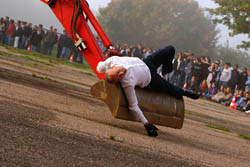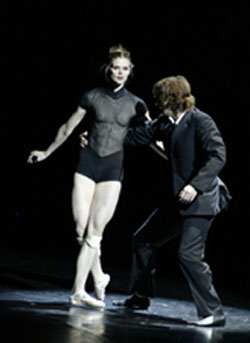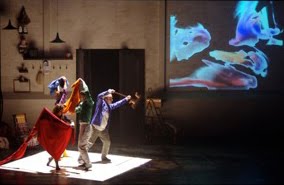Editor’s Note: For the 2009 edition of the Festival TransAmérique in Montréal, Philip Szporer, Marie Claire Forté and I each contributed impressions and reflections. Marie Claire was only able to attend a few shows, which happened to be the ones I could not. Between us, we’ve created a comprehensive two-part review of the festival offerings. I encourage readers to scroll through to find sections about the various works and artists (in bold) and to return to browse other sections. – MA
Bodies: Concrete, Multiple and Diffuse – Part 2
Philip Szporer: Reinventing strategies of looking at the body, digging into reality, adjusting to one another, and the politics of performance, these are a big part of the content and research at play in many of the FTA offerings. Off course, at the OffTA performance central, the Théâtre d’Aujourd’hui, Montrealer Karine Denault presented new work, “Not I & Others”. The program note indicates that the performance is a transformation of the work of Erwin Wurm, Kenneth Goldsmith, Caroline Bergvall, Samuel Beckett and Bruce Nauman. How she references these multiple artists is a mystery, and it gives the proceedings a whiff of the formulaic. It also reminds me that I have research to do after the show, and perhaps I’m not prepared to gauge this performance without this prior knowledge.
The dancer/choreographer and musician/collaborator Alexandre St-Onge are on a simple, cool, white performing area surrounded by an audience on all four sides. Many people are seated on the floor, while others occupy a couple of rows of bleacher seating. Clothes are in random piles, and St-Onge has his table filled with his laptop and outer sound accoutrements. Sequences are cobbled together. We hear a disembodied voice say, “Arm flex, release, left, right, etc…” With each instruction, Denault moves accordingly. A foot slides left, her body bends. We watch her clear, unadorned movement. Then Denault speaks into the mic, but her utterances are often barely audible. St-Onge picks up a pile of clothes and drops them centre-stage. She lies down, a limp presence. He topples a microphone stand, then lies flat on the stage in another area and chimes in a falsetto – “oooo” and various other sounds.
Denault and St-Onge deploy a number of activities: she puts on a layer of clothing and eventually goes into a semi-shoulder stand. Later she gasps into the mic, and he captures it, making the sound reverberate. We hear the sound of running water. Again, she speaks into the microphone: “Talk about the infrastructure of your work.” Her voice is being fragmented technologically as she speaks. Oranges get thrown about the stage. St-Onge rubs his forearm with the microphone, and then against his scalp. His aural/vocal sound antics keep me awake. Denault sets about piling the oranges. By now the overall treatment is flat, and not as allusive or resonant as perhaps desired.
While St-Onge strums his guitar and makes on-key noises, she puts one foot in front of the other and looks bored, unaffected. It is what it is. St-Onge’s constant plucking on his guitar begins to sound like a fire alarm, which wakes a few people up, literally. Denault too seems suddenly alert, and starts kicking one leg up, then another.
A woman in a lime green sweater gets up and changes places in the crowd (most people are on the floor). I think she’s a plant, because hers is the brightest movement I’ve seen in the last fifteen minutes. The piece eventually ends. Like I said, it is what it is. But I’ll reference Gertrude Stein, who said it best, “There is no there there.”
“Eonnagata”, conceived and performed by Robert Lepage with dancer/choreographer Russell Maliphant and dancer Sylvie Guillem, is neither pure theatre nor pure dance, and a bit of a bust. But first things first: the show is full of the brilliant visual stage wizardry (a table becomes a cell, a womb, a cradle) that Lepage has become famous for, and then there is the flat-out awe-inspiring lighting design from long-time Maliphant collaborator Michael Hulls. Under his direction the architecture of the space is eloquent unto itself. Then there are Alexander McQueen’s jaw-dropping gorgeous and seductive costumes – an array of revealing petticoats, leotards, transparent kimonos, codpieces and unitards. Unfortunately, the dancers seem constricted by the costumes at times, no matter how elegant or attractive (and there are lots of costume changes).
For those familiar with Lepage’s multi-layered oeuvre, several thematic elements reappear: he tackles the investigation of identity and the transgendered body, and embraces once again his love of Japanese theatre culture (in particular, onnagata, the tradition of male actors playing female characters), plus there’s lots of sword play that surfaces throughout the performance. Lepage interweaves the sections with text. He and the other performers tell us the history of the Chevalier d’Eon, a spy in the service of Louis XV, who challenged gender norms. There is much speculation (as the story is told) about his/her true sex, but this mystery actually serves the razzle-dazzle of the sets, costumes and various shenanigans that are mounted.
There’s been much ballyhoo about Lepage’s dancing. In fact, he has taken a major plunge, and when the trio slide and glide under and over tables they do so with ease, but other choreographed sequences seemed to be played in slow motion, with no obvious logic, perhaps to account for the differing abilities. The prolific Guillem’s ronds de jambes en l’air and developpé are pretty phenomenal, and a couple of the Maliphant-Guillem duets connect with passion. But the show doesn’t add up to much in the end, as if the main collaborators couldn’t develop the material beyond a certain point.
To single out a “best” in the FTA lineup, my nomination would go to Julie-Andrée T., the Montréal-based performance artist, well known in visual arts circles, but also to dance audiences – she’s appeared in work by Martin Bélanger, PME (Jacob Wren), and Benoît Lachambre. She presented two solos during the festival – “Not Waterproof” and “Rouge”.
With “Not Waterproof/L’Érosion d’un corps Erroné”, T. immediately breaks the fourth wall, telling the audience that she doesn’t like to speak. “Can I have a cigarette?” she asks. Someone hands one over. She tells us the best cigarette is when she’s in her dressing room waiting to go on-stage. She pours herself a glass of wine, and gulps it all down. A trickle of the red wine stains her white blouse. She asks for another cigarette, and someone gladly complies. She calls out to cultural columnist Francine Grimaldi, who she remarks is going to leave the show mid-way. It’s OK, says T., “but you wouldn’t do that to Robert Lepage”. The audience laughs easily. (This was not set-up in advance. I had been speaking with Grimaldi before the show’s start, and with one of the festival handlers she was trying to figure out how to get to the Émard street performance that night, as the two shows overlapped). Four partial cigarettes and an entire bottle of wine are consumed (second-hand smoke, beware!). I wondered if she really was downing that much wine, and from what then transpired, I can assure you that she certainly did. By now, her white blouse is quite stained, and T. is looking a bit haggard.
She sits down and starts playing an electric violin. When she is done, she takes one of the bow’s horsehair strings, rolls it into a ball, and places it into her pocket. Shortly afterwards, she pulls out the string, and begins to “play” her face, pulling the string along her lips, under her nose, creating a grotesque mask, a disfigured face. She later puts a bunch of feathers in her hair. During these sequences you can hear a pin drop. The line between intensity and danger is significantly heightened.
She opens a tube of blue paint and dabs the colour on her mouth. She sticks the lower part of her face into a long cylinder of water. (Several other cylinders dot the stage, and large vessels of frozen water are suspended. With the warming of the room, chunks fall into metal receptacles.) Clouds of the colour fan into the liquid. Rising from that position, she goes to the back of the stage and raises her arms and hands, and repeatedly bends forward, occasionally emitting a “whoosh” sound. She continues until she spews the excess wine. She spits and spits, and she repeats the bending. An arc of reddish liquid flies out, staining the floor. The smell of stale wine permeates the hall. The feathers are askew on the floor too. By now she is gasping for air.
Her next maneuver is curious: she balances on one foot, as if seemingly regaining her balance or her senses. She then pulls a panel of the backdrop off the wall and stuffs it into the back of her blouse — she gains a hump. The next sequence is perhaps the most troubling: she applies red paint to her knees and elbows and proceeds to balance herself on four small cylinders, each filled with water. As she is perched in this precarious position, the fear is that she will gash herself should the cylinder break or disintegrate due to the sheer force of her weight. Eventually she disengages herself, without incident.
Other sequences ensue, and the entire show is enhanced by the participation of collaborators, lighting designer Jean Jauvin, and composer and sound designer Laurent Maslé. T. builds an intensely physical performance, but what is most striking is her understanding of time, and her development of a rapport with her audience. By the end, when she is sprawled on the floor, a cylinder filled with red liquid perched over her mouth, the water cascading down her face, soaking her clothing. Resembling a corpse, she has left an indelible mark.
Her subsequent performance, “Rouge”, starts off simply: T. chomping down on a red pepper. When her mouth is full, and some of the juices are trickling down her face, onto her blouse, she asks the audience a question. Because her mouth is stuffed, the question is muffled. She tries a second time, to no effect. She digests a bit more, looks exasperated with us, and finally comes the question, in English, “What colour is this?” “Red,” people shout. She walks over to a large chest, in which she has an arsenal of mainly red objects. With each new object in hand, she asks the same question, “What colour is this?” sometimes the phrasing changes, sometimes the tone, but the answer is always the same. When she finally pulls out a green fly swatter, she again asks, and people respond, “Green!” She pulls out a can of spray paint, and, voilà!, she makes it red too. “What colour is this?” is her soundtrack, and each tableau and action evolves from this simple remark.
The performance proceeds, alternately coy and calm, playful and antagonistic, the accumulation of objects, acts and words raising the intensity of our experience. Finally, as she begins to colour parts of her body, she begins altering her physicality. A breast is awash in red. Three cans of spray paint streak her face, the coloured lines making quadrants on her skin.
Again T. works with time and space, understanding measures, creating a sophisticated palette of activity. As the show progresses, she manages to erase the traces of her personal identity, and through transformation, she uses metamorphosis poetically. This is rigorous work, deeply rooted in the body, that is enlivening and profoundly thought-provoking.
Marie Claire Forté: I popped in during the last days of the FTA this year, and Julie Andrée T.’s “Rouge” was my first of three stops. I am not well versed in performance art, but “troubling”, Philip, is a great word to describe my experience watching the finely crafted performance. The space was so specifically transformed, from the white backdrops, the white floor with shiny silver cables hanging from the ceiling and strung across the space, to a landscape of red objects and fluids and lights. I was entirely compelled by her presence, Laurent Maslé’s often minimal and sometimes transformative sound interventions and Jean Jauvin’s mostly stark, bright light.
The following evening, I revisited Ame Henderson’s /dance/songs, which I first engaged with as a dancer in a creative process with her at Le Groupe Dance Lab in 2006 and saw in performance at the Pixel Project’s Off-amériques in 2007. You reviewed this show Megan, in a dialogue with Kathleen M. Smith in 2006. “[…] there’s something,” you wrote, “ – in my experience and our discussions of this performance event – that reminds me of descriptions I’ve read and photos/videos I’ve seen of Judson Church performances, and of late 60s or early 70s contact improvisation performance events.” This makes me think about you and Philip commenting on the question of work feeling dated or being old (Singular Sensation, l’Orgie de la Tolérance, Körper); it’s funny how this can be both a fault and a quality.
My last stop was the anticlimactic Lepage, Maliphant and Guillem event, Éonnagata. I concur with your appreciation of the lights and costumes, Philip. Michael Hulls’ lights were magical; an interpreter would take a step and subtlety change colour. Alexander McQueen’s corset-on-crack costumes were also beautiful. Unfortunately, the angle of my seat allowed me to see many of the technical comings and goings that constructed the vignettes. And the pacing within the tableaux was quite even, whether it was a medium-tempo dance with a large Japanese puppet, a medium-tempo sword fight or a medium-tempo monologue. While I tried to adopt the even-ness, the flow between abstraction and narrative was too lumpy to sustain my attention for an hour and forty minutes. I delighted in a few moments. Guillem, dressed in a cream-coloured robe with large, square sleeves, tells a Greek myth about Zeus separating the genders, which were both formerly in one two-headed, four-armed and four-legged body. Maliphant is stuck to her back, waving his hands with hers like Vishnu, sometimes lifting her when she points up to Zeus, the sky, and catching her as she falls and points down to the humans on earth. Lepage also has a fun monologue as a priest writing a letter about the spy’s ambiguous gender, waving his quill about emphatically.
Thus ended my brief FTA experience. I am curious to hear more about both yours.
PS: Just to add to your comments about /Dance/Songs: The nod to the Judsons and the Contact Improvisers connected more to the welcoming low-key atmosphere of the show, than its content. The audience seated in an L-shape around the square stage at the intimate Théâtre La Chapelle was a first clue, and the up-close proximity of the performers was a strong second. Eric Craven’s rock-style music drives the piece, and two of the performers – Claudia Fancello and Chad Demski – have a winning excessive physicality, and if there was scenery I could see them gleefully chomping right into it. But they are at a disadvantage, because the third performer, Croatian Matija Ferlin, is a whole other kind of mover – fearless and exceptional are words that come to mind as descriptions of his work, but it’s so much more than that. One moment he’s like a colt with his lean body bent on invention, and another, he’s like a terrorist on a mission. Whether he’s battering his head against Fancello’s stomach, or sticking a mic in his mouth, eliciting a variety of guttural moans, he’s exceptional. Watching him tear into movement, his body seizing and releasing, is exciting on a level I rarely experience in a theatre.
The audience that attended was divided — some were partisan supporters, while a whole other section of the public seemed perturbed and, frankly, bored. Perhaps it was hype that brought them to the show. Regardless, they just weren’t connecting to the concert concept or much else of what was happening. For my part, I enjoyed the live video feed that came and went – it was just another series of perspectives that I felt embodied the rock concert experience. And while the “songs” weren’t always memorable, that wasn’t the point, I suspect. The text portions, for instance recounting a trip to Australia, were opportunities to shift tone and give p use. I didn’t strive for meaning or look for metaphor in any of what I was watching, but again I didn’t feel that was the object of the night.
MA: Jumping back in, there were a few other shows I saw before I had to head back to Toronto. “Studies in Motion” by Vancouver’s Electric Company Theatre was billed as a theatre piece with choreography by Crystal Pite. Always intrigued by Pite’s work, I made my way on opening night. Tickets had been printed with the wrong address and had people making their way back to the theatre from halfway across the city. Thwarted further by a bomb threat in the Métro, FTA Artistic Director Marie-Hélène Falcon begged the audience to be patient as they held the curtain for what seemed ages. Then, about ten minutes into the work, the fire curtain dropped in front of the stage. A tech called into the house to request our patience and another chunk of time passed before the event resumed. Overall the work, about the life story of late nineteenth-century photographer Edward Muybridge, was unremarkable. Pite’s movement sequences in some cases were effective, with actors posing in various stages of a movement and strobes flashing to create the semblance of Muybridge’s famous sequential stills of humans and animals. Otherwise, the story didn’t build well, in part because of the intercut flashbacks to Muybridge’s earlier days. The lighting effects worked at times but became laborious over time and made the work too thick with effects for me. And so back to the dance.
The following evening I attended “Le Show Poche” by Catherine Tardiff and company, which someone translated for me as “The Lame Show”. The person in question seemed to think that shoe fit. Performed by a group of consummate artists (Marc Boivin, Sophie Corriveau, Daniel Parent, Jean Turcotte and Guy Trifiro), the work meandered through a series of rather absurd scenes, based in movement but not really dance (thought that’s a whole debate in itself that we won’t enter here!). The players or characters wear track pants and sneakers for the most part, and each transitions through a series of t-shirts with logos, brands and team-sport numbers on them, all colours and styles of the 70s and 80s. They move into the space to execute the scenes and withdraw to the sides to sit or stand waiting or changing costumes in plain view but dim light. In one early scene, they gather to roast marshmallows around a would-be campfire, created with a pile of cellophane or foil, effectively lit in flickering red. In another scene, someone traverses the space on sheathed ice skates, decked out in toque and mitts. A man plays sappy tunes on 45s on an old record player, while another dances. Corriveau appears in a gown. They stand on chairs, hop about, shuffle, walk, crawl. Two men share one pair of pants in a goofy duet. The space appears momentarily lit like a ball court with blue and red lines. Soccer balls ensconce four lighting instruments high above the stage. Someone dances a hornpipe. The group effects an ensemble moonwalk. They parade through a grand chain. A crossing by three “animals” includes a very effective camel, complete with huffing sounds. Some moments are quite funny; others are humdrum, while others are just this side of banal. Tardiff and company have a knack for effective timing, composing or improvising through the arc of each scene with just the right amount of rhythmic variation, pause and punch. In a way, the work has the quality of a sitcom from the 1980s. At times though, the performers’ conviction opens a visceral or emotional channel that connects directly with the audience. The show didn’t rock my world, but I enjoyed it. It did seem to rock the world of the group of teenagers in the audience the night I saw it. Many stood and cheered.
Immediately after this, I hustled down to Rue Emery to catch Émard’s “Le Grand Continental”, which was facing the question of rain. The skies held off and the event took place. I was late to arrive and so stood on a nearby step and craned to see, mostly arms and heads. It was a fun performance, rigorously choreographed with intricate arm and upper body phrases, and the dancers were extremely committed to their expression. The crowd loved it, as your source also said Philip. The music (Martin Tétreault) was mixed live (DJ Diane Labrosse) along with the lights (Lucie Bazzo) and, following the performance, the crowd did join in for a dance or two. From my vantage point, it was hard to get a strong sense of the piece and I did question the choice of street. At that point, Rue Emery is quite narrow and with really no options to view from afar or above, unless of course you live in one of the overlooking apartments.
For my final evening at FTA, I attended Benoît Lachambre and Su-Feh Lee’s “Body-Scan”, an enigmatic work presented at Usine C. Having previously seen Jan Fabre’s über-spectacle in the same space, it was quite a shift to witness this subtle and rather non-presentational work. As the audience enters, the performers occupy the space in various ways. Lachambre and Lee sit on chairs facing each other downstage centre. They’re engaged in conversation, looking at each other, leaning in with a light touch on the knee and whispering in the other’s ear. Sometimes they smile in a shared moment of communication. They are extremely soft with each other, gentle and receptive. Other performers are scattered about the space lying on mattresses curled against set pieces. I feel myself soften and in my seat; a warmth spreads under my skin and I sense a subtle tingle on my arms and neck as I follow Lachambre and Lee’s gestural duet. They speak directly to us at one point, telling us that they are going to share a little of their practice with us. A phrase stands out: “La tendue de la force de sa douceur”.
The space is filled with piles of puffy clothing, sleeping bags and quilted comforters. Partial walls form partially enclosed spaces around the sides of the space, with the mattresses and several industrial dollies scattered about. Upstage centre, several large screens present a series of projections throughout the work, some are recognizable as bodies and body parts (possibly early twentieth-century medical images), others are more enigmatic forms. The sound (Jesse Zubot) is an ambient electronic scape with strings; heavy crashing guitar occurs later in the work, along with other found and manipulated sounds. The lighting design (Philippe Dupeyroux) has the house lights up for a good portion of the work; however, at a certain point, I realized they had dimmed.
A man enters from the house, walks down the aisle to the downstage right corner, undresses, folds his clothing simply and slides into a sleeping bag, pulling the hood flap tight around his head. There’s absolutely no rush and we are invited to witness the process. The work evolves and develops as the performers dive into their experience, sensing and responding to each other’s presence and movement, sometimes through direct physical contact with themselves or with each other (at times extremely intimate) and sometimes from a distance across the space. Some dancers sleep on stage for certain sections. They move indiscriminately between, around and behind the various partial walls and screens, not making a distinction between entrances, exits and ongoing movement. Partway through, they announce that they will take a five-minute break for both them and us to make necessary adjustments.
Donning and doffing articles of clothing, wrapping themselves in quilts, the performers’ quality of touch remains primarily soft and gentle throughout. They exchange genuine glances and smiles, reminding me of the improvisational mode in which they are working and lending a playful tone to certain moments. Lee performs a solo section in the nude, beautifully there and vulnerable before us, not presenting a dance per se, but moving through her experience of this moment. Lachambre also performs a solo, in which he seems to be turning his body inside out somehow, pressing and squeezing his torso deeply and emitting gutteral, visceral grunts and groans. I feel my own innards churn a little.
The end involves a higher energy ensemble section in which the various comforters and sleeping bags are laid out flat and then lifted, spun and released by the performers so that they float and waft back to the floor. Each comforter has a large silk-screened face on one side (presumably the performers?) and a solid colour on the other side. Sometimes they land face-up, sometimes not. The performers dance around and across the space in joyful play (I think momentarily of a pajama party).
This was a challenging work in that it didn’t provide a conventional “dance performance” frame or structure for the audience. All frames of reference were blurred to some degree – between performers and audience, between presenting and experiencing, between one and the other, offstage and on, waking and sleeping, etc. – with no easy answers provided. It was definitely not a “show” but rather a sharing of a practice, as Lee and Lachambre indicated in their opening address. I would like to see this work again as I feel there is much more to absorb.
And that concluded my FTA 2009 experience. During the week, I was also able to catch a few informal presentations: a work in development, “Klõk”, by George Stamos, Lynda Gaudreau’s “Black Out” and Paul-André Fortier’s “Cabane”. I won’t comment here on these presentations since they were more like open studio showings than performances, except to say that I was intrigued by all three and hope to have a chance to see them all again in full.
Overall, it was an intense week of dance going, with enough space around the major events for a bit of digestion. I was sorry not to sink my teeth into the OFFTA events; scheduling was tricky and I wasn’t able to find easy information about that programming. I’ll have to make it a point next time around. Philip, you noted earlier that the festival offerings focussed on “reinventing strategies of looking at the body”, and I would agree, though I would tweak that to include not only ways of looking at the body but also ways of being, experiencing and performing the body. I’d like to be able to revisit the whole dance portion of the program and reflect more on the interconnections and oppositions between the works. Certainly there were few, if any, “purely dance” performances, with most exploring a meeting, and in some cases effective integration, of movement and music, movement and visual effects, movement and theatre, movement and performance/visual art. The programming was clearly linked to the Euro-Western contemporary art line, save for Bruno Beltrao from Brazil, whose work nonetheless explores an urban cultural form. This is one lens; there are of course many others.
Thanks to you both for your thoughts and words. This is a hefty piece full of juicy detail.
Part 1: thedancecurrent.com/review/bodies-concrete-multiple-and-diffuse-part-1
Tagged: Contemporary, Dance Theatre, Festival, Performance, Site-Specific, Montréal , QC





